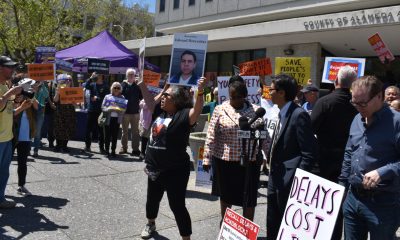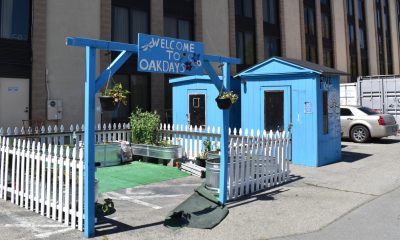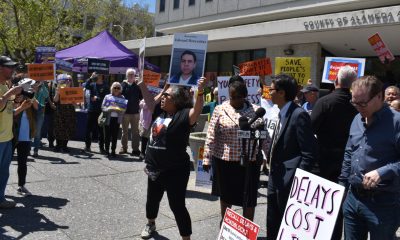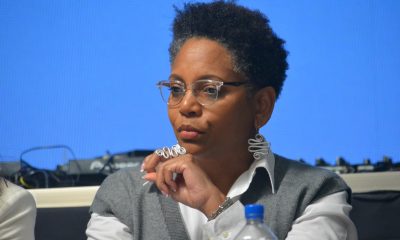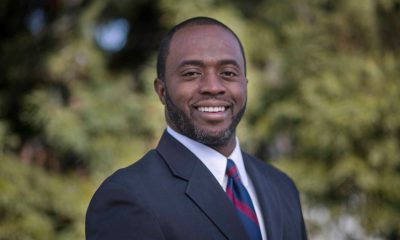Bay Area
It’s Filipino American History Month a Note from an Asian American Israeli
As a pacifist, I find that the news from the Middle East is depressing. The death tolls will rise higher before any talks can begin between the sides. So, I pray for people I know there, an estimated 35,000 Filipinos in Israel, a small part of the 2-3 million Filipinos in the Middle East. But one friend is unique. A Filipino American born in the U.S., he married the Israeli sweetheart of his youth and moved to Israel nearly a decade ago. He is essentially an Asian American Filipino Israeli.

OPINION
By Emil Guillermo
It’s my birthday this week. I am 118.
No lie.
Prior to this week, I figured age was just a number, and stopped counting.
But now I’m into counting each and every year. With honor.
It hit me as I prepared for talks commemorating October as Filipino American History Month.
My father would have been 118 this year. And only now have I realized that his life has been my life; History is my story.
He was born in the Philippines under the American flag in 1905.
That’s seven years after the U.S. bought the country from Spain after the Spanish American War in 1898. The Treaty of Paris sealed the deal 125 years ago. The U.S. paid $20 million mostly for the Catholic artifacts. Note, that’s less than the Golden State Warriors pay some of their star players.
Through the treaty, my father became more than a Filipino. He was a colonized American national, and able to come to America without papers.
He was legally undocumented.
But when my father came to California in 1928, he was not lucky enough to immediately start a family. Not in 1928, ’38, ’48, but in the ’50s.
What happened? Was he a bumbler in loud, unappealing clothes? Or was he just caught in Filipino American history, a racist one where Filipinos were plugged up, stopped up, dammed up.
Or maybe just damned.
Men like my father were brought in to replace excluded Chinese and Japanese labor, which made the male-to-female ratio among Filipinos around 14-1. You couldn’t find a Filipino wife. Anti-miscegenation laws were also in play. Filipinos were shot or lynched just for looking at a white woman. That often caused riots where angry whites protested the “peaceful penetration” of Filipinos.
My father was only able to start a family well after World War II when Filipino women were allowed to come more easily to America. But my father didn’t take part in the segregated U.S. Army. His health and age prevented him from enlisting. But that meant he couldn’t get the biggest boost into the American middle class and generational wealth—the GI Bill.
We never owned a home, never owned a car, and lived paycheck to paycheck.
If you didn’t serve in the military, you relived the ’20s, the ’30s, and the ’40s in the ’50s, ’60s, and ’70s.
But he did meet my mother. Though not a traditional Filipina “war bride,” she had survived the Japanese occupation of Manila. She hid under sewing machines at a seamstress shop to avoid being forced to become a Filipina ‘comfort’ woman to Japanese soldiers.
She was saved by a Spanish citizen who took her under her wing and brought her to San Francisco.
When she met my father in the early 1950s, it was well after the war. But then, the delayed second generation of Filipino Americans began.
As part of the second generation, I was born in the U.S. But I was always treated like the first, my father’s generation.
Filipino American history has always controlled my life. Even when I break glass ceilings, I am wounded by the shards.
During Filipino American History Month, it only makes sense to honor my father. My story begins with his on the day he was born under the American flag in the Philippines. A colonized American national who was too often treated as less than in America.
So today, this week, is my birthday. I am 118. I will always gladly explain how. It’s in the history of our treatment in America.
A Note from An Asian American Israeli
As a pacifist, I find that the news from the Middle East is depressing. The death tolls will rise higher before any talks can begin between the sides.
So, I pray for people I know there, an estimated 35,000 Filipinos in Israel, a small part of the 2-3 million Filipinos in the Middle East.
But one friend is unique. A Filipino American born in the U.S., he married the Israeli sweetheart of his youth and moved to Israel nearly a decade ago.
He is essentially an Asian American Filipino Israeli.
When Israel was attacked, I contacted him to make sure he and his family were fine.
“We are fine, away from the southern conflict areas,” he wrote to me. “A major intelligence and operational failure by the IDF [Israeli Defense Forces]. The watchmen were sleeping. Israel’s 9/11.”
I was relieved to hear he was safe.
“There should have been a trigger with troops rushing in if there was a breach of the high-tech security fence. A quick reaction force. Failure of intel component,” he continued.
But he knew on Sunday something bigger and more deadly was brewing.
“The West Bank is ringed with troops. The northern border is on high alert. And Hezbollah leader Hassan Nazrullah learned his lesson in 2006,” he said. “A big ground war is coming. Two months tops on the fighting. But it is going to be bloody.”
I asked him if he was leaving for safety.
He said he’d canceled a planned trip to the U.S. and was sure he would volunteer for security duties once things were organized.
But he sounded clear and determined as you’d expect an Asian American Filipino Israeli.
“We aren’t leaving.”
He said it with a fearless defiance, full of pride and the willingness to endure whatever it takes in the fight for the right to exist.
It’s the reason the deaths will keep rising, until someone says enough. And then talks will begin.
That’s too late. For me, it’s enough already.
Emil Guillermo is a journalist and commentator. He does a micro-talk show on www.amok.com
Activism
Oakland Post: Week of May 8 – 14, 2024
The printed Weekly Edition of the Oakland Post: Week of May May 8 – 14, 2024
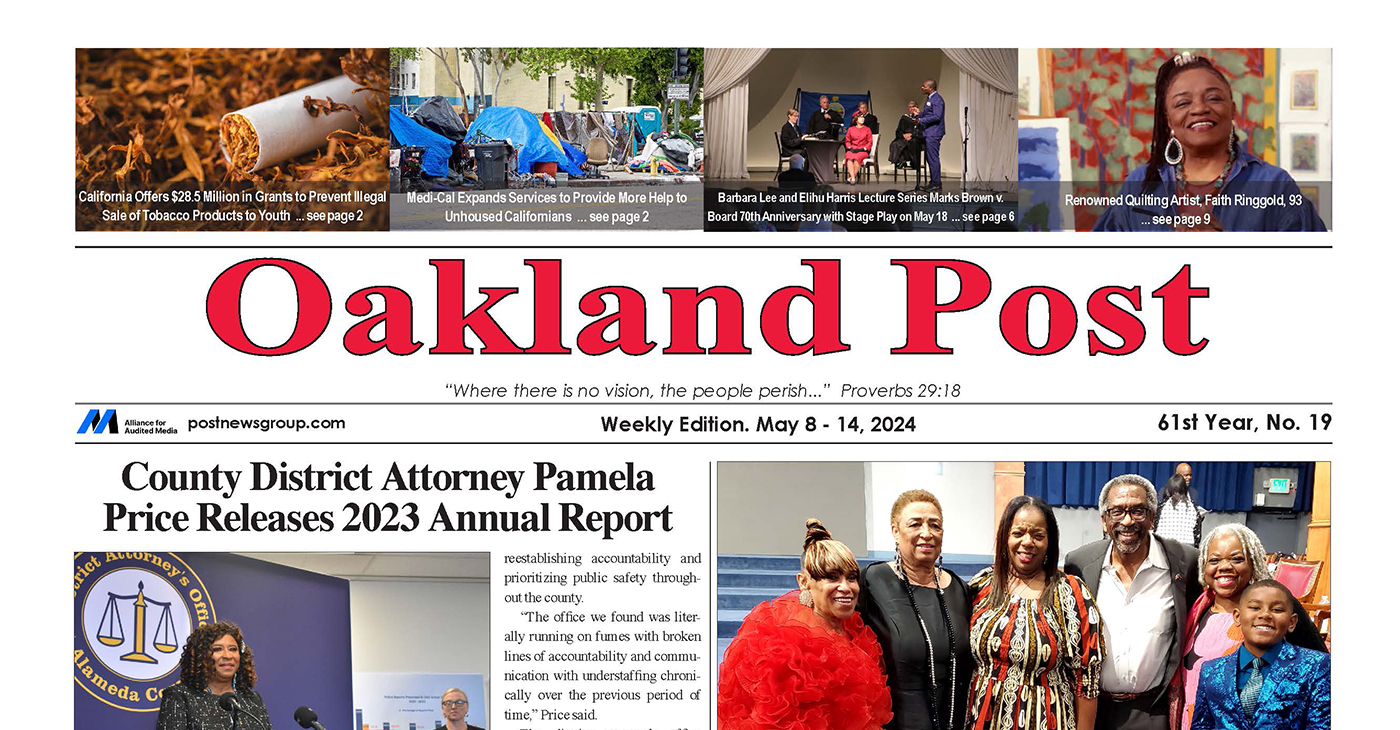
To enlarge your view of this issue, use the slider, magnifying glass icon or full page icon in the lower right corner of the browser window. ![]()
Activism
S.F. Black Leaders Rally to Protest, Discuss ‘Epidemic’ of Racial Slurs Against Black Students in SF Public School System
Parents at the meeting spoke of their children as no longer feeling safe in school because of bullying and discrimination. Parents also said that reported incidents such as racial slurs and intimidation are not dealt with to their satisfaction and feel ignored.

By Carla Thomas
San Francisco’s Third Baptist Church hosted a rally and meeting Sunday to discuss hatred toward African American students of the San Francisco Unified School District (SFUSD).
Rev. Amos C. Brown, president of the San Francisco NAACP and pastor of Third Baptist Church, along with leadership from local civil rights groups, the city’s faith-based community and Black community leadership convened at the church.
“There has been an epidemic of racial slurs and mistreatment of Black children in our public schools in the city,” said Brown. “This will not be tolerated.”
According to civil rights advocate Mattie Scott, students from elementary to high school have reported an extraordinary amount of racial slurs directed at them.
“There is a surge of overt racism in the schools, and our children should not be subjected to this,” said Scott. “Students are in school to learn, develop, and grow, not be hated on,” said Scott. “The parents of the children feel they have not received the support necessary to protect their children.”
Attendees were briefed last Friday in a meeting with SFUSD Superintendent Dr. Matt Wayne.
SFUSD states that their policies protect children and they are not at liberty to publicly discuss the issues to protect the children’s privacy.
Parents at the meeting spoke of their children as no longer feeling safe in school because of bullying and discrimination. Parents also said that reported incidents such as racial slurs and intimidation are not dealt with to their satisfaction and feel ignored.
Some parents said they have removed their students from school while other parents and community leaders called on the removal of the SFUSD superintendent, the firing of certain school principals and the need for more supportive school board members.
Community advocates discussed boycotting the schools and creating Freedom Schools led by Black leaders and educators, reassuring parents that their child’s wellbeing and education are the highest priority and youth are not to be disrupted by racism or policies that don’t support them.
Virginia Marshall, chair of the San Francisco NAACP’s education committee, offered encouragement to the parents and students in attendance while also announcing an upcoming May 14 school board meeting to demand accountability over their mistreatment.
“I’m urging anyone that cares about our students to pack the May 14 school board meeting,” said Marshall.
This resource was supported in whole or in part by funding provided by the State of California, administered by the California State Library via California Black Media as part of the Stop the Hate Program. The program is supported by partnership with California Department of Social Services and the California Commission on Asian and Pacific Islander American Affairs as part of the Stop the Hate program. To report a hate incident or hate crime and get support, go to CA vs Hate.
Bay Area
Mayor London Breed: State Awards San Francisco Over $37M for Affordable Housing
On April 30, Mayor London N. Breed announced San Francisco has been awarded more than $37.9 million in funding from the California Department of Housing and Community Development (HCD) as part of the State’s Multifamily Housing Program (MHP). The HCD loan will provide the final funding necessary for development of Casa Adelante – 1515 South Van Ness, a 168-unit affordable housing project located in San Francisco’s Mission District.
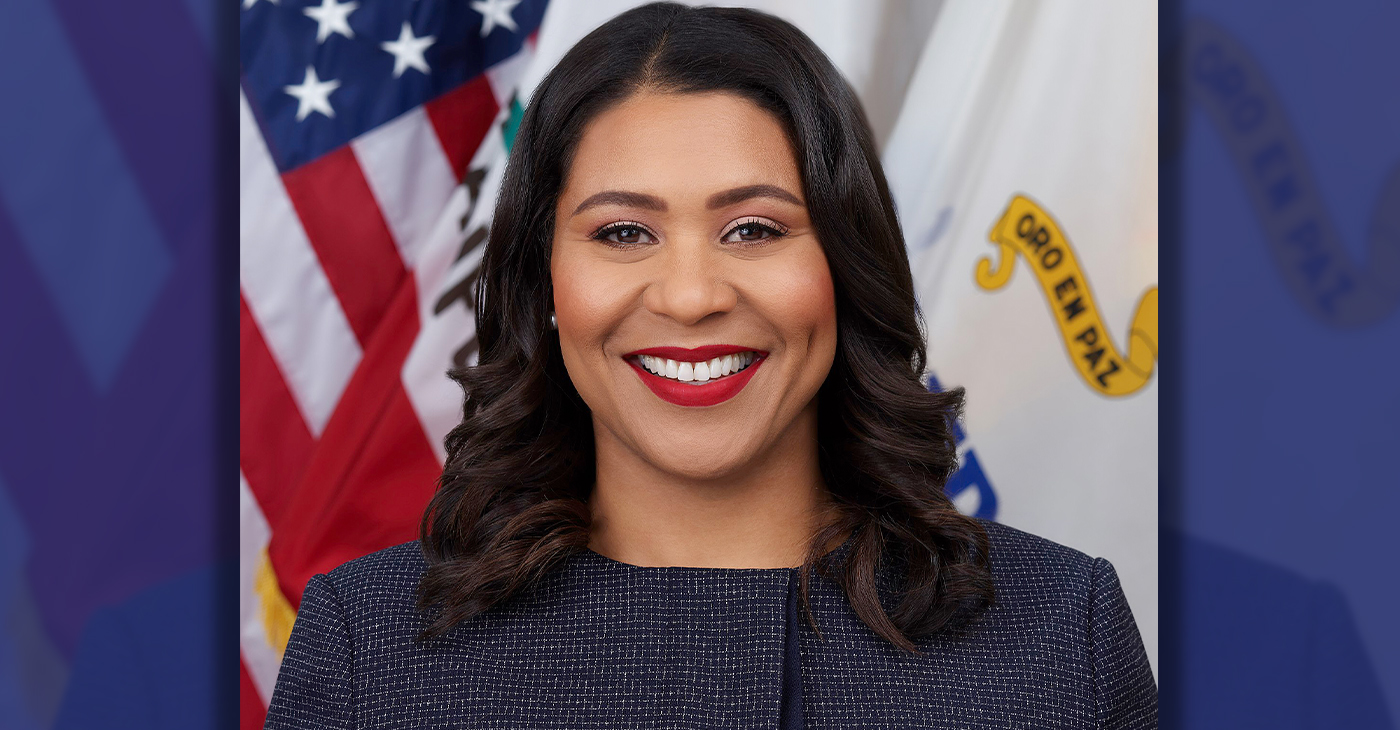
By Oakland Post Staff
On April 30, Mayor London N. Breed announced San Francisco has been awarded more than $37.9 million in funding from the California Department of Housing and Community Development (HCD) as part of the State’s Multifamily Housing Program (MHP).
The HCD loan will provide the final funding necessary for development of Casa Adelante – 1515 South Van Ness, a 168-unit affordable housing project located in San Francisco’s Mission District.
The new development at 1515 South Van Ness Ave. will provide 168 affordable homes to low-income families, formerly homeless families, and persons living with HIV earning between 25-80% of the San Francisco Area Median Income (AMI).
In addition, the project is anticipated to provide family-friendly amenities and ground floor community-serving commercial spaces that preserve the prevailing neighborhood character of the Calle 24 Latino Cultural District.
“This funding unlocks our ability to move on building affordable housing units for families in San Francisco at a crucial time. We understand the level of need for more housing that is accessible, and like the state, the city continues to face a challenging budget cycle,” said Breed. “1515 South Van Ness is a good example of what can be achieved in San Francisco when you have strong community partnerships and an unwavering commitment to deliver on critical needs for our residents.”
“From the beginning of my term as Supervisor, I have fought to bring affordable housing to 1515 South Van Ness” said Supervisor Hillary Ronen. “In the interim, the site has been utilized for homeless services and shelter, and I am thrilled that HCD has recognized the value of this development, and we are finally ready to break ground and bring 168 affordable homes to low income and formerly homeless families in the Mission.”
Owned and occupied by McMillan Electric Company until 2015, the City and County of San Francisco purchased 1515 South Van Ness Avenue in June 2019 with the intent of developing new affordable housing.
In November 2020, the San Francisco Mayor’s Office of Housing and Community Development (MOHCD) released a Multi-site Request for Qualifications (RFQ) seeking qualified developers to build affordable housing on the site, and subsequently selected Chinatown Community Development Corporation (CCDC) and Mission Economic Development Agency (MEDA) in May 2021 to develop the site.
The project is expected to begin construction in winter 2025.
“A strong, long-term push by Mission advocates to make this site 100% affordable is now paying off, with 168 family units that include services and childcare. People of color communities know what they need, and we are excited to be in partnership with a team, consisting of MEDA, CCDC, and MOHCD, that listens,” said Malcolm Yeung, Executive Director at CCDC.
“We are excited to be in partnership with CCDC, yet again, and for the opportunity to develop intergenerational affordable housing in the City’s Mission District,” said Luis Granados, executive director at MEDA.
Increasing housing affordable to lower-income and vulnerable residents is a key priority in the City’s Housing Element which calls for additional funding for affordable housing production and preservation, as well as Mayor Breed’s Housing for All Executive Directive that sets out the steps the City will take to meet the bold goal of allowing for 82,000 new homes to be built over the next eight years.
Tuesday’s funding announcement emphasizes the importance of regional and state collaboration in order to reach our housing and climate goals.
“We are thrilled—not just to bring a project of this size to a community with great need — but to do so with community-based developers and their partners who understand the neighborhood and sensitivities around cultural preservation,” said HCD Director Gustavo Velasquez.
-

 Community4 weeks ago
Community4 weeks agoFinancial Assistance Bill for Descendants of Enslaved Persons to Help Them Purchase, Own, or Maintain a Home
-

 City Government1 week ago
City Government1 week agoCourt Throws Out Law That Allowed Californians to Build Duplexes, Triplexes and RDUs on Their Properties
-

 Activism2 weeks ago
Activism2 weeks agoOakland Post: Week of April 24 – 30, 2024
-

 Business4 weeks ago
Business4 weeks agoV.P. Kamala Harris: Americans With Criminal Records Will Soon Be Eligible for SBA Loans
-

 Community4 weeks ago
Community4 weeks agoAG Bonta Says Oakland School Leaders Should Comply with State Laws to Avoid ‘Disparate Harm’ When Closing or Merging Schools
-

 Community3 weeks ago
Community3 weeks agoRichmond Nonprofit Helps Ex-Felons Get Back on Their Feet
-

 Community3 weeks ago
Community3 weeks agoOakland WNBA Player to be Inducted Into Hall of Fame
-

 Community3 weeks ago
Community3 weeks agoRPAL to Rename Technology Center for Retired Police Captain Arthur Lee Johnson

